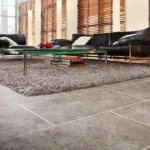Vinyl flooring is a popular choice for many homeowners thanks to its affordability, durability, and wide variety of styles. But what if your vinyl floors are looking a little outdated or worn, and you’re not quite ready to invest in a full replacement? You may be wondering: Can you paint vinyl flooring?
The answer is yes—you can paint vinyl floors—but there are a few important things you should know before picking up a paintbrush. In this guide, we’ll walk you through whether painting is a good option, how to do it right, what paint to use, and tips to make your paint job last.
Is It Possible to Paint Vinyl Flooring?
Yes, it is possible to paint vinyl flooring, but it comes with some caveats. Painting vinyl isn’t as simple as painting a wall—it requires careful surface preparation, the right materials, and realistic expectations for longevity.
Painting works best on smooth, level vinyl floors in low to moderate-traffic areas like guest bedrooms, home offices, or small laundry rooms. If the vinyl is heavily textured, warped, or peeling, painting may not be the best option. Similarly, painting high-traffic areas like kitchens or hallways may lead to faster wear and tear unless properly sealed and maintained.
If your existing floor is tile and you’re considering an upgrade with vinyl instead of paint, you might be interested in whether you can install vinyl flooring over tile, another great budget-friendly option.

Pros and Cons of Painting Vinyl Floors
Pros:
- Budget-Friendly: Painting is far more affordable than replacing vinyl, especially for large areas.
- Custom Look: Choose any color or pattern to match your aesthetic—from solid tones to stenciled designs.
- Sustainable Choice: Painting allows you to extend the life of your current floors, reducing waste and your carbon footprint.
Cons:
- Durability Limitations: Even with sealing, paint can chip or wear over time, especially in high-traffic zones.
- Requires Intensive Prep: Skipping cleaning, sanding, or priming will lead to poor results.
- May Void Warranties: If your vinyl floor is under warranty, painting it could render that warranty void.
How to Paint Vinyl Flooring: Step-by-Step Guide
If you decide to move forward with painting your vinyl floors, follow these steps for the best results:
- Clean Thoroughly: Remove all dust, grease, and debris with a heavy-duty cleaner like TSP (trisodium phosphate). Rinse and let the surface dry completely.
- Sand the Surface: Use 220-grit sandpaper to lightly roughen the vinyl. This helps the primer and paint adhere better.
- Apply Bonding Primer: A high-quality bonding primer is essential for vinyl. Apply one or two coats and let it dry thoroughly.
- Use the Right Paint: Choose durable paint designed for floors—porch and floor paint or water-based epoxy work well. Apply thin, even coats with a roller.
- Let Each Coat Dry: Allow adequate drying time between coats (usually 6–8 hours).
- Seal for Protection: Finish with 2–3 coats of clear polyurethane or floor sealer to protect the paint from scuffs and scratches.
Patience is key. Don’t rush the drying or curing process if you want long-lasting results.
Best Paint Types for Vinyl Floors
The type of paint you use can make or break your project. Avoid regular wall paint, which won’t bond well with vinyl. Instead, consider these options:
- Porch and Floor Paint: Specially formulated for foot traffic and wear, this is the most common choice.
- Water-Based Epoxy Paint: Highly durable and resistant to moisture—ideal for laundry or bathroom floors.
- Chalk Paint: Provides a matte, modern look and good adhesion, but must be sealed well for durability.
Avoid oil-based paints without bonding primer, as they tend to peel off vinyl quickly.
Tips to Make Painted Vinyl Floors Last
To help your newly painted floors stay beautiful:
- Let the paint cure fully—wait at least 3–5 days before placing furniture or rugs.
- Use area rugs or floor mats in high-traffic spots to reduce wear.
- Install felt pads on the bottoms of chairs and tables.
- Clean with mild soap and avoid harsh chemicals or scrubbing.
- Reapply a protective sealant every 12–18 months, depending on usage.
Alternatives to Painting Vinyl Flooring
Not sure if painting is right for you? Here are a few alternative ways to refresh your vinyl floors without picking up a paintbrush:
- Vinyl Floor Stickers or Decals: Easy to apply and remove, great for temporary updates.
- Peel-and-Stick Vinyl Planks: Budget-friendly and quick to install.
- Decorative Area Rugs: Cover unsightly spots while adding warmth and style.
- Complete Replacement: If your floor is too damaged or if you want a long-term solution, new vinyl installation might be the better choice.
Is Painting Vinyl Flooring Worth It?
If you’re on a budget and want a fresh new look without tearing up your vinyl floors, painting vinyl flooring can be a smart, short-term solution. With proper prep, the right paint, and good sealing, painted vinyl flooring can look great and last a few years.
However, it’s important to weigh the time, effort, and durability against your expectations. For long-term results or high-traffic areas, replacement might be the better investment.


